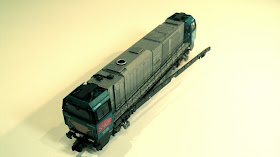* "N Scale" being used loosely here as some of these are from Japan and are a slightly larger 1:150 or from the UK and 1:148 'scale', although I don't see a horrendous difference once on the layout.
So now that its 2013 I thought I would provide an update on some of my N Scale cars with the sole purpose of sharing information, opinions and thoughts about this fun and relatively inexpensive area of the hobby!
In fact, given how inexpensive these little cars are (usually, not always), its easy to assemble a nice little collection fairly easily, so I'll break this post up into two posts!
Also....remember that these cars are REALLY small and the photos of these vehicles are like 50 times larger than what your eye would normally see! So details look bad, tiny fibers look like cables, and bits of dust look like boulders! Its like Fantastic Voyage all over again!
I.M.U. / Euro Modell
I.M.U. was a small European manufacturer that made an interesting range of vehicles based on European prototypes apparently based off old Wiking molds? I first got exposed to these models a couple years ago when I bought a lot of used N scale cars off of eBay which include several I.M.U/Euro Modell and Marks cars I haven't seen before. The problem with identifying these models is that they have no markings at all, so its a bit of a puzzle! I think the company is now called Euro Modell, however all the packaging I've seen for these models still says I.M.U., so I don't know.
Below is an unidentified (Trabant maybe?) vehicle which may or may not be I.M.U. plus a Citroen DS (the sporty green car!) and a Citroen HY van.
One of the few Volvo's in N scale is also an I.M.U. model; the blue/purple vehicle on left is a Volvo "Buckel", while the vehicle on the right is the unmistakable Citroen 2CV.
In general, I.M.U models lack moving wheels and details and casting are fairly crude by today's standards, and window glass (for the most part, the die-cast Ferrari is the exception) doesn't sit flush at all. They are not particularly cheap either (the die cast ones are fairly pricey
Busch
A definite step up in quality is Busch. Windshields, finer printing and overall better appearance - although sadly no turning wheels! Their range seems really focused on emergency or police vehicles, so they seem somewhat limited in terms of how much you could put on your layout (on the other hand, maybe Quinntopia is just the place where every private citizen drives around in their own little emergency vehicle?).
Below are two different Mercedes models, but they have some cool looking Opels, and a 1950 Buick and Chevy Pick Up that I think a lot of folks would be interested in. Check out some of their current offerings here.
Fleischmann
Taking a bit of a smaller step back we have a couple of sports cars from Fleischmann. As may not be surprising from the quality of these cars, I suspect they go back to the 1980's or earlier as they are fairly crude. But you can add a Porsche 911 or a Ford GT to your N scale layout...it'll give all of those people in their emergency vehicles something to chase!
Herpa
One of my favorites lately are these NSW Sport Prinz models from Herpa! Better known for their small airplane models, not surprisingly Herpa does a really nice, quality job with their cars.
Herpa has also in recent years taken ownership of Roco's famous Mini-Tanks line of plastic military vehicles (which was primarily an HO scale venture, although they had a few 1/160 items). So you can now get this terrifically named and looking "UniMog" in a Herpa package (along with some Leopard tanks and M113 APC's if you need them).
Kyosho
Need some buses? Needs some buses for Tourists? Surprisingly, there seems to be a disproportionate number of buses in N Gauge than cars (Check our the offerings from Mini's, Rietze and others), but a couple of my favorites are these die-cast metal and plastic buses from Kyosho from Japan. If the name Kyosho sounds familiar is because they are probably better known for the Radio Control products than their N gauge models!
Minis
If your road transportation needs are more from the 1950's-1960's era, and you don't mind a preponderance of Mercedes and other European vehicles (along with primarily German advertising on the trailer sides), then Minis is a great brand to check out. They make some really beautiful trucks with trailers as well as other commercial vehicles.
They are not limited to just commercial vehicles, as this really sharp, precise VW van demonstrates!
Marks
Marks is an interesting company. Again, a focus on European prototypes, they have some of the most expensive cars in N scale available! The one 'premium' version I have, is another Volvo. Amazingly similar in some aspects to the much cheaper and cruder plastic version from IMU. Although the photo does not represent it well, the detail and printing on this rally car Volvo are really sharp. It also cost me too! I think this one car was the same price as 3 or 4 cars from other manufacturers.
That's if for "Part 2"! Part 3 is coming! Thanks for reading!












































